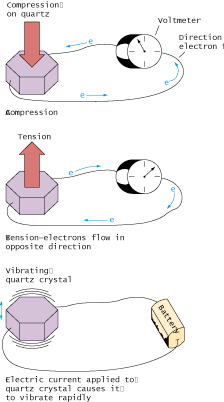 <a onClick="window.open('/olcweb/cgi/pluginpop.cgi?it=jpg:: ::/sites/dl/free/0072402466/30425/qtzbox.jpg','popWin', 'width=NaN,height=NaN,resizable,scrollbars');" href="#"><img valign="absmiddle" height="16" width="16" border="0" src="/olcweb/styles/shared/linkicons/image.gif"> (48.0K)</a> <a onClick="window.open('/olcweb/cgi/pluginpop.cgi?it=jpg:: ::/sites/dl/free/0072402466/30425/qtzbox.jpg','popWin', 'width=NaN,height=NaN,resizable,scrollbars');" href="#"><img valign="absmiddle" height="16" width="16" border="0" src="/olcweb/styles/shared/linkicons/image.gif"> (48.0K)</a> | Each quartz watch contains a thin wafer of quartz sliced along a particular
crystallographic orientation. The quartz acts as a "pacemaker"
to keep the hands or the electronic display precisely on time. The property
of quartz that makes this work is called piezoelectricity, which means
that pressure applied to a crystal creates an electric current. Quartz
is used to make gauges that measure high pressures (for instance, the
water pressure on a deep-ocean submersible vessel). The greater the pressure, the stronger the electric current. With tension
(outward pulling), the electric current flows in the opposite direction.
Electrons move one way in an electric circuit if the quartz crystal
is under pressure and the other way if the quartz is under tension.
If you reverse the process and apply an electric current to the quartz
crystal, the crystal changes shape slightly. More precisely, it expands
and compresses; and it will do so extremely rapidly and with remarkable
regularity. The expansions and compressions are tiny vibrations that
occur at the rate of about 100,000 vibrations per second. Thus for each
minute that your watch runs, the quartz wafer in it shrinks and expands
6 million times (the electricity for this is supplied by the watch's
battery). |

